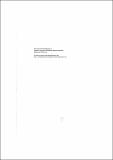| dc.contributor.author | Herren, Urs | |
| dc.date.accessioned | 2011-12-14T13:26:32Z | |
| dc.date.available | 2011-12-14T13:26:32Z | |
| dc.date.issued | 1988-04 | |
| dc.identifier.citation | Herren, Urs (1988) Pastoral peasants: household strategies in Mukogodo division Laikipia District. Working paper no. 458, Nairobi: Institute for Development Studies, University of Nairobi | en_GB |
| dc.identifier.uri | https://opendocs.ids.ac.uk/opendocs/handle/20.500.12413/1317 | |
| dc.description.abstract | Recent reviews of pastoral development in Africa have invariably deplored the lack in understanding about pastoral socioeconomic systems. The paper argues that this is related to the fact that pastoral studies, a field dominated by anthropologists until the late 1970s, have been largely shielded from the dynamic developments in the analysis of peasant societies. It is maintained that there is a need to firmly re-link pastoral and peasant studies, as most pastoral societies in Africa have been thoroughly peasantized over the last two decades.
More specifically, there is a need for studies starting from a microeconomic analysis of the basic production units (the households), in order to understand the processes involved in the rapid internal differentiation of pastoral societies. The major contention of the present study is that differences between households, in wealth but also other factors like education and the position in the domestic cycle, translate into qualitatively different options and constraints. These again make households adopt diverging strategies that need to be understood for planning development interventions.
The paper reviews the methods used for data collection in Mukogodo Division, Laikipia District. Special attention is given to a rapid sample selection method, called "informant wealth-ranking", as the establishment of a small but reliably representative sample is crucial for studying highly mobile and dispersed pastoral households.
Based on data collected in the first seven months of fieldwork, the large disparities in wealth between Mukogodo households are exemplified. It is then shown how wealth-related differences in management and marketing strategies are reflected in herd structures, drought recovery rates, pastoral labour inputs, the rate of labour migration and the specific development of dependency relations. | en_GB |
| dc.language.iso | en | en_GB |
| dc.publisher | Institute for Development Studies, University of Nairobi | en_GB |
| dc.relation.ispartofseries | Working Papers.;458 | |
| dc.rights.uri | http://creativecommons.org/licenses/by-nc-nd/3.0/ | en_GB |
| dc.subject | Rural Development | en_GB |
| dc.title | Pastoral peasants: household strategies in Mukogodo division Laikipia District | en_GB |
| dc.type | Series paper (non-IDS) | en_GB |
| dc.rights.holder | Institute for Development Studies, University of Nairobi | en_GB |
| dc.identifier.blds | 318512 | |


